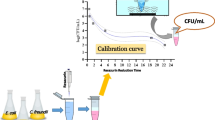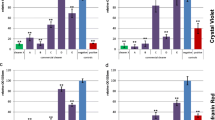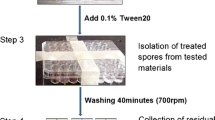Abstract
A method based on the use of resazurin (RSZ) is described to determine the number of viable Bradyrhizobium japonicum cells in culture medium. The observation of RSZ reduction can be done spectrophotometrically or visually. B. japonicum strains behaved differently when the reducing time was considered. This methodology can be used to determine the number of viable cells during the liquid culture stage of inoculant production.
Similar content being viewed by others
References
Glass, R.H., Scott, A.E., Ericsson, R.J., Drowin, M.I., Marcoux, L.J. & Sullivan, H., 1991 The resazurin reduction test provides an assessment of sperm activity. Fertility and Sterility 56(4), 743–746.
Kummerlin, K., 1982 Resazurin test for microbiological control of deep-frozen shrimps (Technical note). Journal Food of Technology 17, 513–515.
Otsuka, G. & Nakae, T. 1969 Resazurin test paper determining the sanitary quality of raw milk. Journal of Dairy Science 52,(12), 2041–2044.
Vincent, J.M. 1970 A manual for the practical study of root nodule bacteria. Oxford: Blackwell Scientific Publications.
Author information
Authors and Affiliations
Rights and permissions
About this article
Cite this article
Lemos, E., Carareto-Alves, L. Resazurin reducing time as an indicator of Bradyrhizobium viable cell count. World Journal of Microbiology and Biotechnology 14, 139–141 (1997). https://doi.org/10.1023/A:1008849206064
Issue Date:
DOI: https://doi.org/10.1023/A:1008849206064




